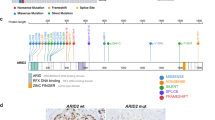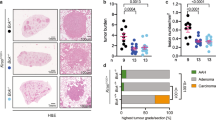Abstract
BAF180 encoding a subunit of the human SWI/SNF chromatin remodeling complex maps to 3p21, in a region where frequent allele loss has been detected in lung cancer. BAF180 can be mutated and has tumor suppressing properties in breast cancer. In addition, another member of this complex, hSNF5/INI1, is a known tumor suppressor gene (TSG) for malignant rhabdoid and childhood central nervous system tumors. Thus, BAF180 is a strong candidate TSG for lung cancer. The objective of this study was to determine whether BAF180 mRNA or protein expression was inactivated or abnormal in lung cancers to prompt detailed DNA promoter methylation or mutational analyses. In 30 non-small-cell and 26 small-cell lung cancer cell lines, most of which had 3p21 allele loss, BAF180 mRNA and protein expression were evaluated by RT–PCR using three sets of primers and Western blotting using two anti-BAF180 antibodies. In all cases, BAF180 was expressed and no abnormal size BAF180 protein was detected. Finally, we found no amino-acid sequence coding mutations in five non-small-cell and five small-cell lung cancer cell lines, while we did find a new splicing isoform of BAF180 (AY281068). We conclude that abnormalities of BAF180 are not frequently involved in the pathogenesis of lung cancer.
This is a preview of subscription content, access via your institution
Access options
Subscribe to this journal
Receive 50 print issues and online access
$259.00 per year
only $5.18 per issue
Buy this article
- Purchase on Springer Link
- Instant access to full article PDF
Prices may be subject to local taxes which are calculated during checkout


Similar content being viewed by others
References
Ae K, Kobayashi N, Sakuma R, Ogata T, Kuroda H, Kawaguchi N, Shinomiya K and Kitamura Y . (2002). Oncogene, 21, 3112–3120.
Alberts B, Johnson A, Lewis J, Raff M, Rpberts K and Walter P. . (2002). Molecular Biology of the Cell 4th ed. Garland Science: New York.
Bochar DA, Wang L, Beniya H, Kinev A, Xue Y, Lane WS, Wang W, Kashanchi F and Shiekhattar R . (2000). Cell, 102, 257–265.
Bultman S, Gebuhr T, Yee D, La Mantia C, Nicholson J, Gilliam A, Randazzo F, Metzger D, Chambon P, Crabtree G and Magnuson T . (2000). Mol. Cell., 6, 1287–1295.
Burbee DG, Forgacs E, Zöchbauer-Müller S, Shivakumar L, Fong K, Gao B, Randle D, Kondo M, Virmani A, Bader S, Sekido Y, Latif F, Milchgrub S, Toyooka S, Gazdar AF, Lerman MI, Zabarovsky E, White M and Minna JD . (2001). J. Natl. Cancer Inst., 93, 691–699.
Esteller M and Herman JG . (2002). J. Pathol., 196, 1–7.
Flaus A and Owen-Hughes T . (2001). Curr. Opin. Genet. Dev., 11, 148–154.
Guidi CJ, Sands AT, Zambrowicz BP, Turner TK, Demers DA, Webster W, Smith TW, Imbalzano AN and Jones SN . (2001). Mol. Cell Biol., 21, 3598–3603.
Klochendler-Yeivin A, Fiette L, Barra J, Muchardt C, Babinet C and Yaniv M . (2000). EMBO Rep., 1, 500–506.
Maitra A, Wistuba II, Washington C, Virmani AK, Ashfaq R, Milchgrub S, Gazdar AF and Minna JD . (2001). Am. J. Pathol., 159, 119–130.
Roberts CW, Galusha SA, McMenamin ME, Fletcher CD and Orkin SH . (2000). Proc. Natl. Acad. Sci. USA, 97, 13796–13800.
Sekido Y, Fong KM and Minna JD . (2003). Annu. Rev. Med., 54, 73–87.
Sevenet N, Lellouch-Tubiana A, Schofield D, Hoang-Xuan K, Gessler M, Birnbaum D, Jeanpierre C, Jouvet A and Delattre O . (1999). Hum. Mol. Genet., 8, 2359–2368.
Strobeck MW, Knudsen KE, Fribourg AF, DeCristofaro MF, Weissman BE, Imbalzano AN and Knudsen ES . (2000). Proc. Natl. Acad. Sci. USA, 97, 7748–7753.
Varga-Weisz P . (2001). Oncogene, 20, 3076–3085.
Versteege I, Sevenet N, Lange J, Rousseau-Merck MF, Ambros P, Handgretinger R, Aurias A and Delattre O . (1998). Nature, 394, 203–206.
Wistuba II, Behrens C, Virmani AK, Mele G, Milchgrub S, Girard L, Fondon III JW, Garner HR, McKay B, Latif F, Lerman MI, Lam S, Gazdar AF and Minna JD . (2000). Cancer Res., 60, 1949–1960.
Wong AK, Shanahan F, Chen Y, Lian L, Ha P, Hendricks K, Ghaffari S, Iliev D, Penn B, Woodland AM, Smith R, Salada G, Carillo A, Laity K, Gupte J, Swedlund B, Tavtigian SV, Teng DH and Lees E . (2000). Cancer Res., 60, 6171–6177.
Xue Y, Canman JC, Lee CS, Nie Z, Yang D, Moreno GT, Young MK, Salmon ED and Wang W . (2000). Proc. Natl. Acad. Sci. USA, 97, 13015–13020.
Zabarovsky ER, Lerman MI and Minna JD . (2002). Oncogene, 21, 6915–6935.
Zöchbauer-Müller S, Minna JD and Gazdar AF . (2002). Oncologist, 7, 451–457.
Acknowledgements
This work was supported by NC1 Grants P50 CA70907 (Lung Cancer SPORE), CA71618, and the Gillson Longenbaugh Foundation.
Author information
Authors and Affiliations
Corresponding author
Rights and permissions
About this article
Cite this article
Sekine, I., Sato, M., Sunaga, N. et al. The 3p21 candidate tumor suppressor gene BAF180 is normally expressed in human lung cancer. Oncogene 24, 2735–2738 (2005). https://doi.org/10.1038/sj.onc.1207694
Received:
Revised:
Accepted:
Published:
Issue Date:
DOI: https://doi.org/10.1038/sj.onc.1207694
Keywords
This article is cited by
-
Exome sequencing identifies frequent mutation of the SWI/SNF complex gene PBRM1 in renal carcinoma
Nature (2011)
-
The SWI/SNF complex and cancer
Oncogene (2009)
-
Identification of a tumor suppressive critical region mapping to 3p14.2 in esophageal squamous cell carcinoma and studies of a candidate tumor suppressor gene, ADAMTS9
Oncogene (2007)



